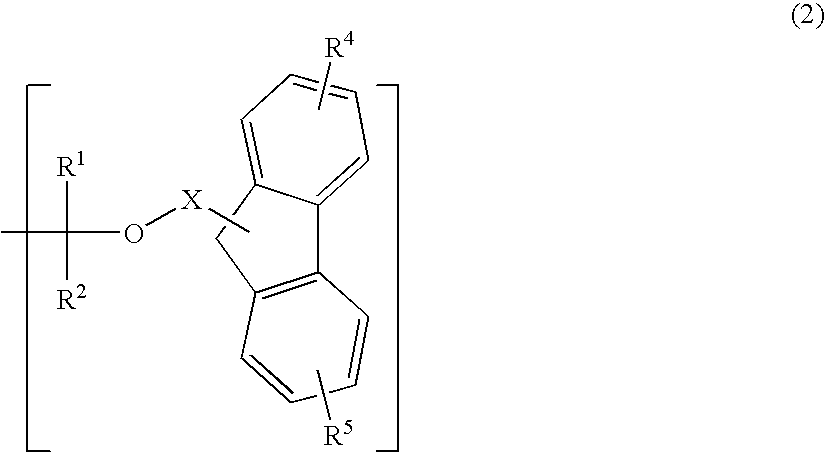Positive resist composition and patterning process using the same
a composition and resist technology, applied in the field of polymer, can solve the problems of affecting the composition quality of the mask, the tendency to a lower sensitivity of the resist, and the size misalignment of the mask on the size change of the pattern on the wafer, etc., to suppress the diffusion rate of the acid, the pattern configuration is good, and the sensitivity and resolution are good.
- Summary
- Abstract
- Description
- Claims
- Application Information
AI Technical Summary
Benefits of technology
Problems solved by technology
Method used
Image
Examples
synthesis example 1
[0184]Into a 2-L flask were charged 8.1 g of 4-acetoxy styrene, 10.6 g of 6-acetoxy-2-vinylnaphthalene, and 40 g of tetrahydrofurane as a solvent. The flask was cooled to −70° C. under a nitrogen atmosphere, and the procedure of a deaeration under vacuum followed by a nitrogen blow was repeated for three times. After heated to a room temperature, 1.2 g of AIBN (azobisisobutyronitrile) was added as a polymerization initiator, and after the temperature was raised to 60° C., the reaction was carried out for 15 hours. The reaction solution was poured into 1 L of isopropyl alcohol for precipitation, and the white solid obtained was redissolved in 100 mL of methanol and 200 mL of tetrahydrofurane, added by 10 g of triethylamine and 10 g of water, and then a deprotection reaction of the acetyl group was carried out at 70° C. for 5 hours. The reaction solution was neutralized by acetic acid, concentrated, and dissolved in 100 mL of acetone. In a similar manner to those shown in the above, p...
synthesis example 2
[0187]Into a 2-L flask were charged 14.6 g of 4-acetoxy styrene, 1.5 g of indene, and 40 g of tetrahydrofurane as a solvent. The flask was cooled to −70° C. under a nitrogen atmosphere, and then the procedure of a deaeration under vacuum followed by a nitrogen blow was repeated for three times. After heated to a room temperature, 1.2 g of AIBN (azobisisobutyronitrile) was added as a polymerization initiator, and after the temperature was raised to 60° C., the reaction was carried out for 15 hours. The reaction solution was poured into 1 L of isopropyl alcohol for precipitation, and the white solid obtained was redissolved in 100 mL of methanol and 200 mL of tetrahydrofurane, added by 10 g of triethylamine and 10 g of water, and then a deprotection reaction of the acetyl group was carried out at 70° C. for 5 hours. The reaction solution was neutralized by acetic acid, concentrated, and dissolved in 100 mL of acetone. In a similar manner to those shown in the above, precipitation, fil...
synthesis example 3
[0190]Into a 2-L flask were charged 14.6 g of 4-acetoxy styrene, 1.4 g of benzofurane, and 40 g of tetrahydrofurane as a solvent. The flask was cooled to −70° C. under a nitrogen atmosphere, and then the procedure of a deaeration under vacuum followed by a nitrogen blow was repeated for three times. After heated to a room temperature, 1.2 g of AIBN (azobisisobutyronitrile) was added as a polymerization initiator, and after the temperature was raised to 60° C., the reaction was carried out for 15 hours. The reaction solution was poured into 1 L of isopropyl alcohol for precipitation, and the white solid obtained was redissolved in 100 mL of methanol and 200 mL of tetrahydrofurane, added by 10 g of triethylamine and 10 g of water, and then a deprotection reaction of the acetyl group was carried out at 70° C. for 5 hours. The reaction solution was neutralized by acetic acid, concentrated, and dissolved in 100 mL of acetone. In a similar manner to those shown in the above, precipitation...
PUM
| Property | Measurement | Unit |
|---|---|---|
| reaction time | aaaaa | aaaaa |
| reaction time | aaaaa | aaaaa |
| temperature | aaaaa | aaaaa |
Abstract
Description
Claims
Application Information
 Login to View More
Login to View More - R&D
- Intellectual Property
- Life Sciences
- Materials
- Tech Scout
- Unparalleled Data Quality
- Higher Quality Content
- 60% Fewer Hallucinations
Browse by: Latest US Patents, China's latest patents, Technical Efficacy Thesaurus, Application Domain, Technology Topic, Popular Technical Reports.
© 2025 PatSnap. All rights reserved.Legal|Privacy policy|Modern Slavery Act Transparency Statement|Sitemap|About US| Contact US: help@patsnap.com



